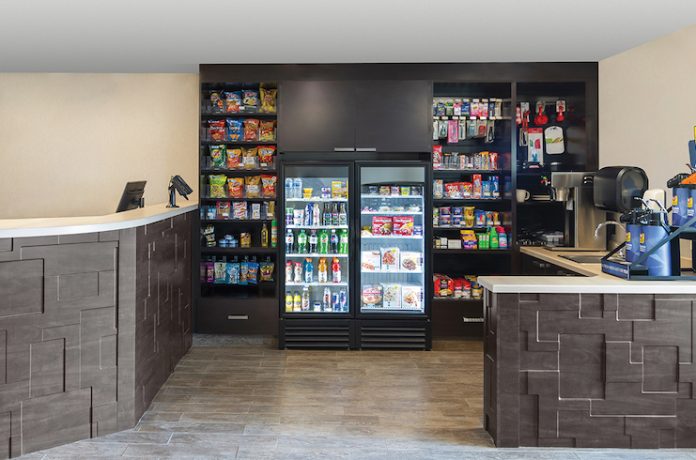While consumers’ interest in grab-and-go items rose with the COVID-19 pandemic, the trend has been in place for at least a decade as part of a shift toward less-structured eating behaviors. The change is most evident among younger generations. “While older generations are holding on to the traditional three-times-per-day meal pattern, younger generations are fueling the grab-and-go snacking lifestyle,” said Tina Griffin, manager of foodservice and lodging commercial strategy, Kellanova Away From Home.
The popularity of these convenient F&B choices is also a sign of hectic lifestyles, irrespective of age. “Between busy mornings, school drop-offs, commutes, and managing busy schedules of activities, consumers are looking for options that keep them fueled throughout the day,” added Griffin. As a result of these lifestyles, snacking patterns tend to be irregular. Griffin cited a telling statistic from “The Future of Snacking” (April 2023) by consumer behavior consultancy Circana: “Seventy-one percent of consumers don’t plan when they will eat a snack; they just grab one as they need it.”
Accordingly, grab-and-go venues at hotels have become significant revenue generators, as many people seek to continue those eating habits when traveling. But maximizing that revenue requires carefully curating the inventory. First and foremost, the selection of grab-and-go items should be informed by the hotel’s market and the nature of its clientele: a more affluent clientele calls for more upscale items, for example. Several other general considerations can also be useful when “stocking the shelves”:
Quality.
According to Griffin, the most important product feature is quality; grab-and-go items are no longer seen as just a means of staving off hunger until it’s time for a quality sit-down meal. “Even while they are eating on-the-go, they do not want to sacrifice on the quality of their foods and beverages,” she asserted. One example is Kellanova’s new Eggo Grab & Go Liege-Style Butter Maple Flavored Waffle, which is inspired by the classic Belgian-style street food. The individually wrapped waffles are made with sweet brioche dough, real butter, pearl sugar, and no artificial flavors and colors.
Balancing healthy and indulgent.
While some guests take travel as a respite from their usual healthy diets, others will continue to look for healthy fare. Accordingly, grab-and-go venues should offer items in both categories. “It’s an ongoing balance of rewarding themselves with their favorite iconic snacks, like Pringles, and a healthier more balanced option, like RXBAR,” said Griffin. RXBAR A.M. Honey Cinnamon Peanut Butter Protein Bar is an example of a grab-and-go item that will appeal to fitness-oriented guests.
Special diets.
“Healthy” typically means low added sugars, low sodium, and the absence of trans and saturated fats and artificial ingredients. But many guests will also look for gluten free, vegetarian, and vegan offerings, and so grab-and-go venues should consider stocking these kinds of items—just as hotel restaurant and room service menus feature those options.
Morning and afternoon.
F&B options should reflect the needs of guests that have a busy schedule morning through late afternoon. “Guests are looking for on-the-go breakfast options, lunch alternatives and afternoon pick-me-up fuel,” Griffin noted.
Local products.
For the many boutique hotels and brands that strive to represent local culture in their design, artwork, and restaurants, it makes sense to continue that theme in grab-and-go venues with items made by local vendors, whether it’s coffee, baked goods, or that iconic local sandwich.
Familiar brands.
At the same time, there are nationally recognized snacking staples that should be part of the mix. “Consumers have gone through times of uncertainty over the last three years, and they are seeking familiar brands, foods, and flavors to provide comfort,” Griffin observed. “They are not only looking for grab-and-go options, but also for snacks that are yummy, rewarding, and nostalgic. Tasting the well-known flavors of their childhood provides the comfort and security they are longing after. Brands matter—87 percent of consumers buy the brands they recognize every time.”
Griffin recommended that hoteliers partner with manufacturers to identify product offerings that best suit their brand, location, and target audience. “Manufacturers can provide subject-matter insights and inputs on best-in-class product sets,” she advised. “Versatility is key even with pre-packaged items like snacks. Identifying top-performing products that are appealing to a wide range of guests throughout various parts of the day will help drive profits.”
Tech-Driven Grab-and-Go: F&B Kiosks Bring Conveniences to Hotel Operators and Guests
Hoteliers have capitalized on the grab-and-go trend by developing venues dedicated to these items. Small areas offering miscellaneous F&B and travel items for guests have expanded into large, inviting, and stylish areas and markets featuring a robust selection of items that often include freshly prepared and artisanal local fare. No longer an afterthought, grab-and-go venues are often integrated with the lobby design in many brand prototypes. Tina Griffin, manager of foodservice and lodging commercial strategy, Kellanova Away From Home, observed that F&B kiosks are also proliferating in the hotel industry. “We are seeing that F&B kiosks are on the rise, and demand for them continues to grow driven by continued labor shortages in the industry,” she said. “Customers have become accustomed with kiosks from the restaurant space. A lot of limited-service concept restaurants have been adding more kiosks than ever since customers are growing used to them. Oftentimes customers prefer ordering at F&B kiosks since they feel less rushed and sometimes even less judged [when they place orders].” Using interactive touchscreens, guests can customize their orders and pay for them without staff assistance. “Younger consumers like Gen Z and millennials have an unmatched comfort with technology, and their preference for technology over brick-and-mortar establishments to conduct business is evident,” said Griffin. “Operators can be setting themselves apart through providing the capability to customize orders.”











